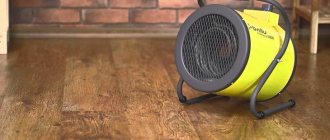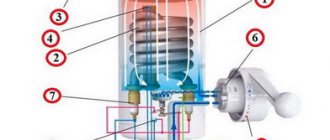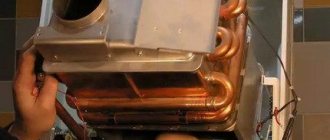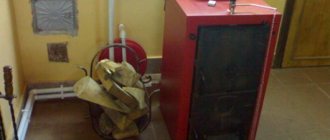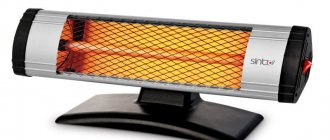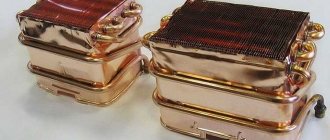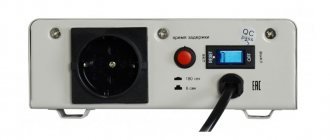Many garage owners use them not only as a haven for cars, but also as work workshops.
And working in a cold room in the mid-season and winter is not a pleasant pleasure. Therefore, car enthusiasts solve the problem of organizing heating as best they can. Today, the main ways to heat a garage are:
- use of electric heaters;
- installation of a stove-stove;
- the use of heaters operating on sawdust and fuel vapors;
- organization of a water-type system.
All of the above methods are justified when organizing garage heating. But the first three are flammable, and if you take into account that there are always a lot of flammable substances in the garage, they must be used with extreme caution. The latter is good, but quite difficult to install; not every garage owner will be able to independently create an effective water heating system.
Not long ago, a new way of organizing heating appeared - installing heaters that emit infrared heat.
These devices gained popularity in a very short time. Why? This is what we'll talk about.
Operating principle of infrared heaters
The operation of such heating devices is based on the generation of heat due to long-wave infrared radiation, which most naturally reproduces the effect of sunlight. The bottom line is that infrared heaters heat the surfaces of objects, and not the air, which then heats things up. Such heating is very effective and comfortable for a person, since it is closest to his physiology.
IR heaters can be used effectively in any room and even outdoors, creating a localized heat transfer zone in the required location.
These heating devices are very economical, which is explained by the absence of losses of generated thermal energy. It is not spent on heating the surrounding air space. The air is gradually warmed up by secondary heat given off by heated surfaces.
The use of infrared heaters brings about 40% savings in energy consumption compared to other types of heating devices. To calculate the required power of IR heaters for a specific room, it is enough to take into account that 1 m³ of volume requires 25...100 W of power. Typically, about 50 W/m³ is taken into account for a garage.
Infrared heaters operate from the mains. Unlike other heater models, they can be placed on the ceiling, which will avoid taking up useful space on the walls and floor of the garage.
Advantages and disadvantages of IR
Garage IR heater equipment, technical indicators and features of use have specific advantages and disadvantages.
Advantages:
- connecting equipment does not require large financial investments;
- the basic package consists of the necessary parts for installation;
- simple connection of an electric emitter;
- installation of gas equipment may require obtaining the necessary permit;
- the possibility of separate zones of the room, rather than the entire garage;
- modern models are protected against overheating of the surface and fire in the event of a fall.
Minuses:
- the power of household appliances is much reduced in order to obtain favorable heating conditions;
- the high cost of the device and the large number of Chinese counterfeits that fill the climate system market.
The IR heating system has no analogues. Compared to a standard heating radiator, they allow you to get instant heating even in a cold building. High efficiency and almost no significant disadvantages explain the popularity of infrared emitters.
We recommend: Features of heating a greenhouse with an infrared heater
YouTube responded with an error: The request cannot be completed because you have exceeded your quota.
- Related Posts
- Features of heating a greenhouse with an infrared heater
Benefits of infrared garage heating
Let's consider all the advantages of infrared heating of the garage:
Variability and ease of installation
Manufacturers offer different types of infrared heating devices: heaters, films, panels. With the help of these inventions you can heat your entire garage very economically. Films, for example, are perfect for covering ceilings, walls, pits and basements.
In addition, they can be covered with a decorative coating. Radiant heat will still flow indoors, warming up the surfaces of the garage. In addition, a thermostat unit can be connected to the infrared heating system, allowing automatic adjustment and effective control.
Each garage owner can choose the best option for their own premises. But while IR heaters still take up little space and sometimes require dusting off, films and panels require absolutely no maintenance and are easily installed and connected by the garage owner.
Types of devices
The type of heating particles installed inside the device is of great importance. At the moment, three options are popular: carbon, ceramic and halogen.
- Ceramic. A good option, since the device does not produce a glow and works only on medium and long waves, without generating dangerous short ones.
- Halogen. They are used less and less because they emit bright light during operation, which is irritating to the eyes. In addition, the heater in halogen models is a source of short-wave infrared radiation.
- Carbon. They glow only a little red, which sometimes has a negative effect on people with allergies and asthma. Much less harmful than halogen ones, but more harmful than ceramic models.
You should pay attention to the thermal insulation of the heating element, which prevents the body from heating and melting. Any chemical additives can release toxic substances when heated for a long time
The optimal insulation option for such IR devices is considered to be basalt, preferably free of impurities.
Separately, it should be noted that recently appeared film IR heaters. With their help you can quickly heat a large area, floor and walls. The generated heat and waves do not harm health and are absorbed by a person for benefit to the body. The maximum heating temperature of film models is about 50 degrees - enough for domestic use.
Economical
IR heaters use electrical energy sparingly and heat more efficiently than other types of heating devices. In addition, you can save money by organizing heating of only the necessary areas, for example, a rack with tools, a workbench, etc.
Resistance to dampness
When the heaters are placed on the ceiling, an analogue of heating by the sun's rays is recreated, which prevents the formation of mold and fungi. This property of infrared heaters is especially valuable for damp garages.
Customer Reviews
Yulia M.
Ballu BIH-AP4-1.0
Careful. Almost invisible under the ceiling. We took it to maintain heat in the living room of a country house. Pleasant sensations. So far we're happy. Disadvantages: The rotating mechanism has a large pitch, it is impossible to adjust it to the desired radius, I’ll say right away that it’s not critical. And I would like more description in the instructions. Comment: In principle, a normal heater, we bought it specifically for the off-season, and immediately bought a regulator for it. Heating is felt throughout the room, not just in spots, as from heating. The only thing is that when I bought it, I couldn’t find information about whether it can be used with stretch ceilings, we are planning to make ceilings, but I would like to clarify. I won’t say anything about power saving, because we’ve been using it for less than a month and the receipt for the electricity hasn’t arrived yet. I am attaching a photo, everything is temporarily connected. We will do repairs and handle everything more carefully.
Alexander P.
RESANTA TVK-2
Advantages: 1. Powerful flow of warm air, heats well. 2. Beautiful design, compact size, and has a carrying handle. 3. There is a rotation mode. 4. Temperature and power can be adjusted. 5. There is protection against capsizing and overheating. Disadvantages: 1. After 2 weeks of operation, clicks appeared that occur when the direction of rotation of the heater changes. It started to get tense. If it doesn’t stop straining or the clicking doesn’t stop, then I’ll take it in for repair) 2. There’s not enough separate button or switch to turn it on and off on the front panel. Turning it on and off using a button would be more convenient than turning the mode switch. 3. A dust filter probably wouldn’t hurt, but it’s not currently in fashion among manufacturers, and maybe it’s not necessary. Comment: Bought as additional heating for home under a computer desk standing by the window. It copes with the task. There was no smell either the first time it was turned on or the subsequent ones. PS: After using it several times, it stopped clicking on its own. Apparently something fell into place)
Alexander Nezvidsky
Solar gas GII-2.9
This heater heats just like a big expensive one, because the area of the ceramics and the gas outlet are the same, the whole difference is in the design and configuration, this heater does not have a gearbox (300-500) rubles and a hose 200 rubles, a regular gas one is suitable (one end We cut off the other one onto the gearbox and pull it onto the heater nozzle, I recommend squeezing it with a clamp for those especially nervous, although everything fits tightly anyway) it’s ready. The CO2 output is minimal and is safe with natural ventilation. I’m heating the garage, in an hour I can heat up 18 m/² to plus 16 with 0 outside the gate. Another 2 kW of wind helps with it in an hour 20 plus at 14 minus outside, it will still depend on the energy efficiency of your room, if you cannot achieve such indicators, think about insulating the room. By consumption: 18 liter composite cylinder with 14 liters of refill, enough for a week when using the heater 5-6 hours a day. Refilling 14 liters costs 430 rubles. A good thing
Valeria D.
Ballu BIH-LM-1.5
Very pleasant warmth, does not dry out the air! Large range of action. Three modes. Metal body. It's on 24/7 and doesn't overheat. Disadvantages: They brought the wrong one, but the S model, it is smaller in size. I'm afraid that its efficiency is less for the same power. It shines at night (but I'm used to it and it doesn't bother me) Short wire. I think it will heat 25 m2 only with good thermal insulation. Comment: I am writing a review specifically for this model (not S), since before ordering I had already purchased such a heater on the market. That’s why I wanted a second one, because I’m very pleased. I use it at my dacha, which is insulated “in places” - at night I just turn it on at 500 watts and direct it towards myself. I sleep under a cotton blanket and feel warm. The room is 12 meters high, if you turn it on at 1000 watts for a couple of hours, it’s hot. It’s convenient that you can just put it next to it and point it at yourself. This will not work with a convector and it heats worse even at a power of 2000 watts
Vladimir Rusakov
Almac IK8
Pros: The design is simple, laconic and at the same time attractive. There is a good choice of colors, for example, I have Almak IK 8 in wenge color, such a pleasant dark brown color, it looks very beautiful against the background of the wooden walls of the attic. There is also white, gold, silver and pine color. Good variety, you can choose one for any room. An interesting fastening in the form of a groove along the entire length and two pendants are inserted into it. Such a simple solution, a very practical heater i.e. you don’t need to measure the distance on the ceiling between the hangers: two hooks in the ceiling and then move the hangers under them and hang the heater. I bought it on the company’s website, on the official one, there are even detailed instructions and all the information on connection and operation. That is, even without seeing the product with your own eyes, you can fully evaluate it. Corresponds to the description. The color also matches. Everyone who comes to visit notices it and mistakes it for a lamp, but if it is turned on, it immediately becomes clear that it is a heater. Disadvantages: The fasteners did not fit into the groove right away. Perhaps there was an influx of paint or something else was in the way. I had to use a flathead screwdriver to pry it out a little there (made in Russia - finish it yourself with a hammer!). There were also minor abrasions on the case, although the packaging was not opened before me. Perhaps it’s the wenge color that gives away all the mistakes. In bright conditions the heaters would not be visible. Comment: There are the same heaters, only of a different size, but the design and everything is generally identical. You can choose one for any quadrature, I recommend taking a closer look at this option if you don’t want to pay dearly, but still need good performance.
Vlad Abramin
Ballu BIH-AP4-1.0
Advantages: 1) Convenience of mounting to the ceiling, and connecting to the wiring, everything is simple and clear. 2) Design Disadvantages: 1) Build quality (but maybe it’s just me, it started clicking, it was solved by disassembling the heater and squeezing some places with pliers); 2) Heating range across the width, and not just underneath. (Example: if you hang it over the bed, lengthwise, but closer to the feet, then after some time the legs will get hot, but the head will freeze; in length, it warms more or less normally, i.e., for example, if the bed is double, then and on the second part of the bed your feet will be quite warm) Comment: In general, it heats the area directly underneath perfectly, it also heats the sides along the length more or less, but not to the sides along the width. Additionally, I connected a Ballu BMT-1 thermostat to the heater. After about a few months, when it was working (heating, when the thermostat does not turn it off), something began to click inside, this does not affect the operation, but now you can’t leave it overnight because it’s loud, judging by the reviews it’s something with the expansion of the metal... In general, this can happen in all models of different companies. In comparison with an oil heater, this is of course better (the power is the same), both in terms of heating and convenience (it doesn’t take up too much space), but not the heating speed, which is slow. Especially if you come in winter and the house is icy, you need to wait at least an hour or two.
Andrey Karpovich
RESANTA TEPK-2000K
Advantages: — Small, takes up little space. — Quite a nice appearance — Lightweight — The cable, although a little short (about 1 meter), is quite enough for my needs — The case does not heat up — Easy to operate — 3 modes Disadvantages: — Lacks a timer — Weak flow Comment: At the time of writing I've been using it for 5 days now, I'm happy with everything. I bought it to heat a loggia (4 sq/m) since it is not insulated. Such an area is heated to a comfortable/room temperature in 15-20 minutes, taking into account that the approximate temperature in the room is +4 - +5. Please note, if you need to heat a room where the temperature is sub-zero or close to zero, then this mini-gun is unlikely to cope with this task, I advise you to take a more powerful model. Initially I didn’t expect much from a budget model, but in the end this model is quite enough for my modest needs
Vova B.
Electrolux EOH/M-6157
Advantages: New technology with accelerated heating. The surface is protected from mechanical damage. It has an interesting appearance, I would say even somewhat futuristic thanks to the round elements, built-in rollers for movement. This is the third year that this radiator has warmed the living room in the evenings and the children's room at night, a very positive impression. The oiler can work for hours without stopping or overheating and I can trust it, thanks to the presence of several safety levels at once. Well-thought-out wheels and a convenient handle allow the radiator to be moved between rooms in a matter of seconds, and in the summer it does not take up much space in the pantry, and the cord is hidden in the body of the radiator itself.
Nikolay S.
RESANTA TVK-2
Advantages: Low price, quickly warms up the room, 90° rotation, ceramic heating elements Disadvantages: The thermostat does not work well: at one adjustment level it can heat for a long time without turning off, or it may not turn on when it gets noticeably cold, as if there are tolerances of several degrees; The rotation around the axis does not stop when the mode is switched to the zero position, only disconnecting from the network Comment: As a heater - an excellent product: it heats quickly, consumes little, there was no smell As a climate control device - it is unlikely to be useful, it heats for a long time until it gets hot ( 24-25* at the heater level), then for a long time it does not warm up to noticeable coolness (20-21*)
Alexander S.
Ballu BHDP-20
Pros: I liked everything. The build quality is the size and most importantly how it works. I have several garages and it can be easily moved from one to another by the handle. The most important thing is that it works completely automatically. I set the desired temperature with the regulator and that’s it. It will turn on itself and turn off when the set temperature is reached. As soon as the temperature drops below the set one, it turns on again and so on until you turn it off or the diesel fuel runs out. Comment: When you turn it on in the garage, it is better to stick it out the door because the first exhaust will stink a little. Then it works in the room with virtually no odor. A 5-liter bottle is enough for a day to maintain the operating temperature in three garages - But not a whole day of work, but as needed .
Valentin N.
RESANTA OMM-7N
Advantages: Size, low power. Disadvantages: Lack of a shutdown button (there is one in the photo, in fact I don’t have one, only a light bulb, but they didn’t show it on the packaging either) Comment: Compact low-power oil heater, just what I was looking for for a balcony. Actual size 30x15x37 cm LxWxH No rollers, for me it doesn’t matter because... It is lightweight due to its compactness and has a handle for carrying. The power is enough to heat a small room (for me it’s a balcony) and at the same time not to overload the electrical wiring. I think it will be very suitable for those who were looking for a heater under the table, etc.
Leonard T.
Ballu BIH-L-3.0
Advantages: 1. The summer veranda is heated all over evenly, this is facilitated by the reflector located behind the heating lamp. 2. During use, it has not lost its attractive appearance: the steel case has not been deformed; The chrome grille, which protects against accidental contact with the heating element, has not rusted. Disadvantages: I had to go shopping to find a special telescopic tripod for installing the heater, because it was not included in the package. Comment: On the open veranda of my cafe you can not only have a tasty snack, but also warm up in cold weather; for this I installed a modern infrared heater, which gives visitors warmth from the moment it is turned on. I set the heating power depending on the air temperature to make it comfortable.
Disadvantages of infrared garage heating
Summarizing the feasibility of using infrared heating devices in garages, it is worth noting their disadvantages:
- the novelty of heaters and the still insufficient awareness of their properties, installation and use features require care when choosing them and creating a heating system;
- quite high cost;
- electricity costs.
But, despite this short list of disadvantages, IR heaters are by far the most harmless and environmentally friendly. And their long service life (minimum 25 years) makes them ideal for use in garage heating.
Infrared ceiling heaters FlexiHIT
The ease of installation and use of an infrared (IR) heater is only an addition to its main beneficial properties: safety, hygiene and energy efficiency.
Converting electricity directly into heat, the lightweight and compact device is installed no more complicated than a lamp.
Components of the efficiency of an IR heater:
- no idle operation - for heating the under-ceiling space;
- durability (20–30 years);
- thermal effect immediately after turning on the device (heat transfer by EM waves occurs at the speed of light);
- reduction of heat loss during ventilation;
- low power consumption.
During operation, the heater does not dry out the air, does not emit harmful substances, is silent and does not create air currents. The safety of this type of heating is evidenced by the widespread use of infrared heaters in children's institutions, sports complexes, and hospitals.
The disadvantage of an electric infrared heater is its dependence on power supply. And its simple dismantling and low weight (3–5 kg) are beneficial to the hunter of other people’s property.
The best thermal curtains for the garage
Thermal curtains are placed above the doorway, on its sides or in the floor (depending on the configuration). They block the penetration of cold into the room, creating a powerful flow of hot air.
Timberk THC WS2 2.5M AERO
Rating: 4.9
Thermal curtain with a needle heater, power 2500 W. It has a wide panel with perforation, from where a strong flow is supplied with an air exchange of 240 m³/hour. The heater has a mechanical control with a thermostat. Ventilation can be started separately from the heating element. The curtain is installed on the doors, where the recommended maximum height is 2.2 m. When overheating, protection is triggered. The heater weighs only 4 kg. The manufacturer promises 7 years of operation of the unit without breakdowns. Buyers in the reviews note that the heater is capable of working 22 hours a day, resting only for 2 hours.
According to experts, the product is best for service stations where customers often visit during the day. The width of 48 cm fits well above the narrow leaf in the gate and reliably cuts off the flow of cold air from the street when the doors open. By design, this is a simple and reliable heater that will last for many years of operation.
Advantages
- good assembly;
- compact model;
- able to work almost without stopping;
- there are protective functions.
Flaws
- cannot serve as the main source of heating;
- Dust accumulates inside.
Operating principle
An infrared heater for a garage is chosen to solve various problems:
- quickly create thermal comfort for performing work;
- locally raise the temperature in a given zone (on a workbench, near a wheel, above the hood);
- control the growth of humidity in the garage;
- maintain a positive temperature near the machine (+5 °C is enough for easy engine starting).
Heating occurs due to the transfer of radiant energy from the heating device to less heated surfaces. The mediator is infrared radiation. Air retains only a few percent of heat (the more, the higher the dust and CO2 content in it).
The space is heated already from objects, which helps to reduce heat loss through the enclosing structures, because They are often poorly insulated.
Infrared radiation travels in a straight line. This is worth remembering when choosing the location of the device for local heating.
In the garage, household heating devices of long-wave infrared radiation, electric and gas, are used.
DIY IR heater
If you want to do something yourself, you can make your own IR heater. There are many ways described on the Internet, from the real to the most incredible. We studied them and selected the two most realistic options for creating an infrared heater for the garage.
The easiest way is to make a heating device from an old reflector with a spiral, which can be purchased at a flea market, according to advertisements on the Internet. In addition to the Soviet-style reflector, you will need:
- steel rod;
- fireproof dielectric (a plate made of glazed ceramics is suitable);
- nichrome thread.
Having all these parts, making a heater is quite simple.
- First, check the integrity of the electrical cable, the plug of the Soviet reflector. If there is dust on the reflector of such a device, it must be removed.
- Take out the spiral and measure its length. Take a steel rod of the same size as the spiral and wind a nichrome thread onto the rod in 2 mm increments. Remove the resulting spiral.
- Take a fireproof dielectric (plate) and place your spiral on it. Connect it to the current so that the turns do not touch. Wait until it warms up. Disconnect from current.
- Take the spiral and place it in the groove of the reflector cone, connecting it to the power supply.
The second option is to make a heater from glass and foil. This option is more suitable for those who are fans of the “Crazy Hands” program, since the heater is made from a bunch of unnecessary things.
Electric infrared heaters for garages
A household IR heater with a closed electric heater is suitable for residential and commercial premises. (“Open” models are more powerful and require a significant distance from objects).
The power of such electrical appliances is 0.5–1.5 kW, the current is 2.5–6.5 A, power supply is 220 V. The operating area of a household heater is 3–15 m2 in winter, in the off-season - 12–30 m2.
The minimum permissible height of its suspension depends on the power of the heater.
For a ceiling height of 2.5–3 m, use an infrared heater no more powerful than 1 kW. Starting a car engine in winter will be facilitated by a 1 kW emitter installed above the hood on the ceiling of an insulated garage with an area of 20 m2. To heat the work area, a heater is installed above it.
Full heating of such a garage up to +20 °C will be provided by two devices of the same power. The design of the infrared closed electric heating device is simple.
The low-temperature tubular electric heater is covered on the front side with a metal plate, and on the back side with a heat-insulating liner. The input box is fixed to the heat insulator. The metal case is equipped with brackets for hanging.
What is infrared radiation
To dispel myths, challenge or confirm what manufacturers say about the safety of IR devices, it is necessary to turn to the physics of the process, understand the principle of their operation and the impact of this type of radiation on humans.
Long-wave IR devices are effective and do not cause harm
Electromagnetic radiation and wavelength
IR radiation is compared to sunlight. It is known that electromagnetic rays emitted by the Sun have properties that depend on their wavelength. According to this parameter, they are divided into several groups: gamma, x-ray, ultraviolet, light, infrared, microwave and radio waves. Infrared radiation is the waves that heat our planet. Thanks to the rays coming from the Sun, the Earth remains warm.
Modern IR devices operate at long waves that are safe for humans in the range from 7 to 14 micrometers
Based on the wavelength of the emitted rays, IR radiation is divided into three groups:
- from 0.75*10-6 to 1.5*10-6 m – shortwave;
- from 1.5*10-6 to 4*10-6 m – medium wave;
- from 4*10-6 to 1 mm – long-wave.
Safe radiation range for humans
Scientists have found that each of us is also a source of energy. The waves we emit represent long-wave IR radiation in a small range: from 6*10-6 to 20*10-6. Studies have shown that radiation in the range emitted by humans does not cause harm. For safety reasons and to avoid harmful effects, in accordance with the requirements of the standard, modern IR heaters operate at safe waves with a length of 7 to 14 micrometers.
Options for placing infrared heaters
Options for placing the IR heater: on the ceiling; on the wall (oblique); on a portable stand.
An IR heater in the form of a panel for a false ceiling (60×60×3 cm, current up to 2 A) is also used as a wall or ceiling heater.
In a garage, a ceiling unit is most convenient. Wall placement significantly reduces efficiency: a significant portion of the radiant heat is absorbed by the walls.
Advantages of ceiling mounting of an IR emitter:
- saving space;
- avoiding accidental contact with him;
- distance from flammable substances;
- maximum heat coverage of objects and people.
What is the real danger?
One of the most likely harmful effects of ICO is drying out the skin. The surface of the skin, being exposed to an infrared source, heats up and moisture evaporates from its surface. But since the subcutaneous layers do not have time to warm up, the body does not produce sweat. Because of this, the skin “dries out” and sometimes burns occur.
Image gallery Photos from
Devices powered by gas cylinders pose a real danger to operation.
When operating infrared heaters, you must strictly follow the manufacturer’s instructions specified by him in the instructions attached to the product.
If gas heating equipment is intended for use in an open area, it should not be used for heating premises.
When using gas infrared devices in the house, they must be installed in rooms with an area no less than that specified by the manufacturer and the room must be regularly ventilated
The real danger of gas appliances
Gas lantern-heater in the country
Outdoor version of gas equipment
Installing a gas heater in the house
If you believe consumer reviews about infrared units, the “baking” effect during their operation is quite common, and the skin especially suffers in infrared saunas.
The effect of intense infrared radiation on people has been studied for a long time - both by physiotherapists and specialists in charge of occupational safety issues. With prolonged or insufficient exposure, infrared rays are considered a highly harmful factor. In physiotherapy, the effect of using radiant heat is considered beneficial in strictly regulated “portions” and a short duration of irradiation.
The permissible intensity of infrared irradiation of the surface of the human body (during a long stay in a room with an IR source) is regulated by SanPiN 2.2.4.548-96
IR heaters also pose a danger to the eyes - thermal damage to the lens and retina can provoke the development of cataracts, as well as contribute to the progression of existing problems with the organs of vision.
Infrared rays directed directly at the head cause migraines, nausea, and deterioration in general well-being. Such complaints from owners of ceiling radiators are especially frequent.
Whether an infrared heater will cause real harm depends in each specific case on the following points:
- The length of the waves emitted by the equipment. Long heat waves are most beneficial for the human body; short ones, penetrating through the skin and even the bones of the skull, do not act in the best way;
- Radiation intensity. The body reacts positively to infrared rays with an intensity of up to 100 W/m2: the activity of biochemical processes increases, vigor appears, and appetite improves. But radiation intensity above 150 W/m2 can be dangerous: it suppresses the immune system and leads to irreversible cell damage;
- Individual sensitivity. Some people respond well to exposure to infrared rays, while others immediately feel worse. You should always listen to your feelings.
It is also worth remembering that there are a number of diseases for which infrared heating is contraindicated regardless of wishes (tumors, cardiovascular diseases).
Fire precautions
What is important to ensure when installing and using high-quality IR heaters in the garage:
- distance from flammable materials (the minimum distance depends on the power of the device);
- parallel connection of several IR heaters;
- no twisting of wires to connect them to the terminal (the wire cross-section is indicated in the instructions);
- extension of suspensions (up to a minimum of 10 cm) that remove the device from the ceiling or cable ducts made of easily melting materials (polystyrene, PVC).
Conclusions and useful video on the topic
Video #1. A short answer from an expert about the dangers of infrared units:
Video #2. Reviews and impressions of real users of IR devices:
High-quality PPIs, selected and placed according to basic security rules, will not cause any harm. They will provide high thermal comfort and good energy savings.
Hardening is useful - but only if it is voluntary and not around the clock! In our latitudes, the cold season lasts from October to April - seven months of bitter cold, rain and snow, sudden frosts and treacherous thaws. Unfortunately, central heating is not always available everywhere, and sometimes it is simply not enough to heat the room.
What could be harmful about heaters? Rumor ascribes to them such vices as a tendency to dry out the air in the room, the release of harmful substances, and increased allergenicity of the air
. Which of this is true and which is a myth?
Oil heaters
Damage to an oil heater.
Modern oil heaters do not emit anything harmful into the room atmosphere during operation, and the advantage of this device is the uniformity of heating. On the other hand, oil heaters actually dry out the air, significantly reducing humidity, which can cause, especially for those who have related diseases or a tendency to respiratory diseases. One more thing: a hot oil heater housing can potentially become a problem. In contact with furniture and finishing materials, it can heat surfaces that can release harmful substances when heated and melted (plastic, MDF, chipboard, some fabrics).
Fan heaters
Damage to the fan heater.
In the process of heating the air in a room, a fan heater uses oxygen from the environment, which is why fan heaters give a certain “suffocating” effect: after a while you may feel that you can’t breathe, you will want to ventilate the room. Of course, there is nothing useful for the respiratory system in this feature of the fan heater. In addition, a fan heater, just like an oil heater, dries the air in the room and reduces humidity. It can be annoying because of the noise it makes when working, especially at night when you're sleeping.
Convectors
Damage to a convector heater.
Convector heaters typically dry out the air and increase its allergenicity. It is known that if a person is sensitive to certain household elements (dust, pet hair, etc.), then the air dried by a heater or air conditioner works against the allergy sufferer. The only way out in this case is to install an air humidifier, frequent ventilation of the room and regular wet cleaning.
Hygiene and injury safety
The location of the IR heater should prevent accidental contact with the emitting plate. Its temperature in low-power devices is about 80 °C.
Handprints on the emitting plate become clearly visible over time. Cotton gloves will protect you from touching the emitter with your palms when installing the infrared heater.
The first switching on of the device may be accompanied by the smell of technological lubricant. It will evaporate within a few hours of operation at maximum power. All that remains is to ventilate the garage.
Three ways to transfer heat
In eighth grade physics lessons, teachers taught that there are three types of heat transfer:
- Thermal conductivity is the transfer of heat from less heated bodies to more heated ones. To carry out the process, contact between bodies is necessary. The object on top of the radiator will heat up due to thermal conductivity.
- Convection is a process in which heat is transferred by flows of liquid or gas. All classical heating systems are based on this effect. Hot air rises, cold air falls down. Therefore, all heating radiators must be located below, near the floor.
- Radiation (radiant heat transfer) – heat is transferred using waves. The infrared radiation discussed above refers to this method of heat transfer.
Reviews on the use of an infrared heater for a garage
Alexey, Vyborg:
“It crackles for a few minutes after turning it on, the instructions say that this is normal. It immediately becomes comfortable in the garage.”
Veniamin, Pskov:
“The ICO is connected via a thermostat with a timer. In the morning it turns on itself, in the evening it remains to work for 2-3 hours. From the moment of installation, it does not require attention to itself.”
Anna, St. Petersburg:
“The emitter is above the exit from the underground garage. Quickly removes ice and snow on the ascent.”
The choice of heating through radiant heat exchange is justified in any room. In the garage, the dependence of an infrared electric heater on the uninterrupted supply of electric current is least distressing. Whereas the opportunity to warm a person, objects, a machine, and not a space, with a waste of time and money, can hardly be overestimated.
How to use the Master 450 CR gas infrared heater for the garage, watch the video:
Are infrared rays beneficial?
The human body also emits radiation waves of 3–50 microns.
Natural infrared radiation has a length of 7–14 microns. In these parameters, the body perceives radiation as much as possible. Using infrared waves of a certain length in therapeutic procedures, doctors keep the patient’s body in good shape and help him recover. The number and duration of sessions is strictly limited so as not to cause harm. Long infrared waves do not cause any harm to the body. With their help, a person can increase the body's immunity.
Are infrared heaters harmful to health? We can say that with the correct selection and installation of the device, the harmfulness is reduced to almost zero.
No comments yet
Dedicated to those who are going to work in the garage in winter, but have not yet taken any measures to heat it, and do not know how to do it correctly. I hope it helps someone.
It's exactly -20 outside.
As you understand, it is impossible to fully work in a garage without heating. Well, then I will present options for electric heating of the garage that I have personally tested. I would like to say right away that in the conditions of the harsh Russian winter, you should not entertain the illusion that buying some kind of household heater for ridiculous money will give you the opportunity to feel comfortable in the garage when it is -15 or colder outside.
100% OPTION IS A WOOD STOVE, but due to lack of space for storing firewood and installing this stove, we omit this option.
Conclusions and useful video on the topic
A short answer from an expert about the dangers of infrared units:
Reviews and impressions of real users of IR devices:
High-quality PPIs, selected and placed according to basic security rules, will not cause any harm. They will provide high thermal comfort and good energy savings.
Modern infrared units are efficient, hygienic and low maintenance - so in many ways they are a really good choice. The main thing is to approach the purchase wisely, and not be tempted by any advertising “odes”.
For apartments, cottages, garages
Electrical appliances are used to heat rooms for a variety of purposes. A suitable model can be selected for a country house, city apartment, small cottage, garage, workshop. All that is required for this is to correctly assess the compliance of the technical parameters, advantages and disadvantages of each type with the assigned tasks.
To the apartment
Convector BALLU BEC/M in an apartment
For a city apartment, you can choose an electric heater of any category. The peculiarity of such premises is their connection to central heating networks, so constant operation of the device is a rare occurrence. As a rule, the heater is turned on either to quickly raise the temperature, or in the event of a failure in the central communications.
The most common choice of consumers is convectors. They can be used for a long time and have moderate power consumption. Fan heaters are not the best choice. In addition to the fact that such models make a lot of noise during operation, they have the greatest “gluttony” in terms of electricity consumption.
If failures in the operation of heating networks are a frequent occurrence, it is better to choose not a convector, but an IR heater. Despite the high power consumption, infrared heaters are more economically feasible. They have the ability to fine-tune and set different operating modes. As a result, maintaining the optimal temperature does not require constant operation of the equipment at full power, which means that electricity consumption is reduced. Convectors can also have similar functions. As a result, when choosing an infrared heater or convector, you can ensure the main requirement - the economic feasibility and energy efficiency of additional heating.
To a country house
Electric heater
The choice of a heater for a country house, first of all, depends on the frequency of its operation. A house outside the city is not always used for permanent residence. Most often, owners come only during the warm season. Houses suitable for year-round living are immediately connected to village or autonomous heating systems. Choosing a heater for such a house is no different from choosing a heater for a city apartment.
A completely different approach is needed if the heater will be used for a seasonal dacha. The heating device must meet two requirements - the ability to quickly warm up the room and the ability to maintain a comfortable temperature for a long time.
The task of quick heating is best handled by convectors (fan heaters) or IR models. On the other hand, installing a complex appliance for the home, which is almost always empty during the cold season, is impractical. The simplest and cheapest heat gun is the best option, especially if there are other heat sources in the house, for example, a brick oven. If heating is not provided at all in the dacha, a combined model is suitable.
For non-residential premises
I want to provide heat not only for a house or apartment, but also for non-residential premises where the owner spends a lot of time. The most striking example of such premises are garages and home workshops. Buildings of this type do not require temperature maintenance for a long time. The main task facing the heater is to quickly warm up the air. The best choice is convectors.
Heat gun Siberian Federal District
The cheapest option is fan heaters and heat guns. They differ, in fact, only in power indicators. After switching on, they provide almost instant heating of the room. Such a convector has considerable power consumption, but it is almost never used in non-stop mode, so heating costs are not high.
You should not choose complex models, infrared heaters. They are expensive. Their purpose is to create and maintain a microclimate. Operation for the short period required to heat the room will not allow the use of different modes, so heating costs will be enormous. This rule is met not only by IR heaters, but also by modern convectors.
Oil coolers work well. Just like a convector, they can quickly heat a room. The heater will successfully maintain the temperature for a short period. The oil does not cool down for a long time, so heat transfer will be ensured even after the heater is unplugged.
Which company should you choose?
There is a large selection of equipment models and manufacturers on the market, including:
- RESANTA is a leader in the welding inverter market. The company presents a large selection of heating equipment: from household devices to devices that are in demand in production and warehouse facilities.
- Ballu is a company that provides climate control equipment. In its work technology, using environmentally friendly materials. Manufactured products meet not only Russian, but also international quality standards.
- Electrolux is a Swedish manufacturer of household and professional appliances. Heating equipment is manufactured using an inverter heating system, which saves energy.
- Solarogaz is a Russian manufacturer based in Penza. It has been manufacturing diesel and gas heaters for more than 20 years.
- Aeroheat is a manufacturer of heating equipment that creates modern products that meet not only quality standards, but also follow new trends (from a technical and design perspective). The company's equipment has wide functionality, advanced technical characteristics and guarantees a high level of comfort.
- Zanussi is an Italian company producing household and heating appliances. The price range of equipment is from economy to middle class. The company has been one of the world leaders in the production of household appliances since 1994.
- Polaris is a Swiss brand, developed by European engineers. Every year the company presents innovative solutions that expand the capabilities and functions of equipment. Polaris heaters are in great demand in many countries around the world.
Types of electric heaters
Electric heaters can use different methods of heat transfer in their operation. Based on this feature, there are several types:
- Convective. This category combines electric convectors, fan heaters, air heaters.
- Radiating. This can include heat-emitting mirrors and IR panels.
- Convective-radiative, combined models. This group includes the most common type - oil radiators.
In order to make the right choice and find the most economical heat source for your home, you need to compare the technical parameters of all categories.
Convective
Electric convectors
The operation of such models is based on the phenomenon of convection. The work looks like this. The fan draws in cold air and passes it through a heating element system. The heated air goes out, rising to the top. The constant movement of air flows in the room ensures uniform heating of the room.
Regardless of the specific type and model, the convector is able to quickly warm up the room. It is indispensable in country houses, where the owners appear from time to time, and the installation of a complex heating network is simply impractical. Convectors are economical devices, but it is still not always advisable to install them as a constant source of heat. The simplest cheap models remain a fire hazard. Convectors with complex emergency shutdown, protection, and safety systems belong to more expensive price categories. Power consumption is quite high. The main disadvantage is the burning of oxygen by heating elements.
Infrared
Such heaters are modern, technically sophisticated devices. They have a more complex operating principle than convectors. The main difference is the use of infrared radiation. Such heat penetrates deeply into surrounding objects, and from them the air is heated. In fact, the operation of infrared heaters can be compared to the sun's rays. Not a single one, even the most modern and advanced convector, can compare with them in efficiency.
IR panel heater
It is impossible not to note the positive effect of infrared rays on humans. Even in a cold room a person will feel warm. If the convector warms the room mainly in the upper part, then the IR heater will provide uniform heating in the full sense of the word.
IR models are almost completely free of the disadvantages that convectors have.
The only and main drawback is significant power consumption. IR devices can hardly be called economical, but electric heaters of this type have the ability to program different operating modes, allowing the device to automatically turn off if additional heating is not necessary. These features help reduce energy consumption.
Combined
Combination models are the cheapest, so they are the most popular on the market. They are absolutely not suitable as the main source of heat. It is worth choosing a combination heater if you plan to use it for a short period of time to slightly raise the air temperature.
In terms of the method of heat transfer, they resemble a convector. The oil poured into the radiator heats up to a predetermined temperature, and the metal surface of the heater begins to release the resulting heat. Just like convectors, combined models can have a built-in fan and turbocharging function. Such elements allow you to increase the rate of heating of the room, bringing the parameter at least a little closer to the performance of infrared devices. Among the shortcomings, one cannot fail to note the significant dimensions, massiveness, and heavy weight.

